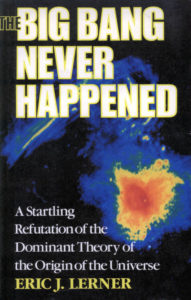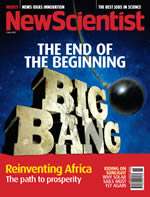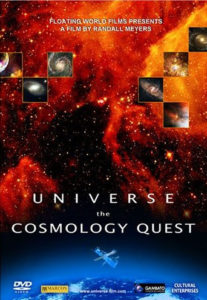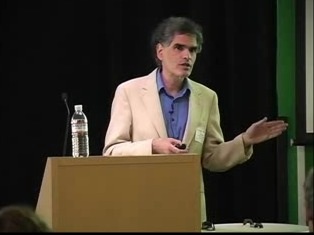Eric J. Lerner (b. 1947 Brookline, MA. USA) is an award-winning popular science writer, plasma researcher and advocate of plasma cosmology,[2] In 1991, he authored The Big Bang Never Happened, a popular science book highlighting Plasma Cosmology in comparison to the Big Bang theory. He has also had a number of peer-reviewed papers published, an estimated 600 popular science articles on a variety of subjects, and co-author a documentary on cosmology.
Lerner is an independent researcher in fusion technology; he is currently the executive director of the Focus Fusion Society and president of Lawrenceville Plasma Physics, Inc. in West Orange, New Jersey,[3]
Contents
Personal history
Lerner was born in 1947 in Brookline, Massachusetts. He received a BA in physics from Columbia University,[4] and did graduate work in physics at the University of Maryland, College Park. He has studied plasma phenomena and laboratory fusion devices, performing experimental work on the dense plasma focus funded by the Jet Propulsion Laboratory in collaboration with the University of Illinois in 1994[5] and with Texas A&M University in 2001.[6] He believes he has demonstrated that the production of useful energy from aneutronic fusion can be made more feasible.[7][8]
Lerner is a critic of the Big Bang theory and advocates an the plasma cosmology approach of an infinitely old Universe.[9] In 2006 he accepted an invitation to be a Visiting Astronomer at the European Southern Observatory in Chile, offered at the initiative of fellow Big Bang critic and MOND enthusiast Riccardo Scarpa.
Lerner is also a prolific general science writer, estimating that he has had about 600 articles published. He has received journalism awards between 1984 and 1993 from the Aviation Space Writers Association.[10]
Lerner is a member of the IEEE, the American Physical Society and American Astronomical Society.
Scientific activities

Plasma cosmology
Lerner is a critic of the Big Bang theory and advocates an infinitely old Universe. He has developed original theories of quasars, Large-scale structure of the cosmos, the Cosmic Microwave Background Radiation, and the origin of light elements all based on the plasma cosmology approach. He claims that the intergalactic medium is a strong absorber of the cosmic microwave background radiation with the absorption occurring in a fog of narrow filaments. He has analyzed data on the surface brightness of galaxies that contradict the predictions of expanding-universe models.
Lerner developed a theory postulating that quasars are not related to black holes but are rather produced by a magnetic self-compression processes (ie magnetic pinch) similar to that occurring in the plasma focus.
Fusion power
Through his work on the plasma focus, Lerner developed a detailed quantitative theory of the functioning of the plasma focus. Based on this theory, he proposed that the plasma focus could achieve high ion and electron energies at high densities, suitable for advanced fuel fusion and space propulsion. Lerner has done experimental work on the plasma focus in collaboration with the University of Illinois in 1994, with Texas A&M University in 2001, and with the Chilean Nuclear Energy Commission. In addition, he developed an original model of the role of the strong magnetic field effect on plasma functioning, showing that this effect could make net energy production more feasible, potentially leading to an economical and safe source of energy.
Presentations
He has presented this approach to fusion at several scientific conferences including (in the past five years) the IEEE International Conference on Plasma Science, 2002: the American Physical Society, 2003 and the XI Latin American Workshop on Plasma Physics, 2005. Lerner was an invited speaker at both the Fifth (2003) and Sixth (2005) Symposia on Current Trends in International Fusion Research, which is sponsored by the UN’s International Atomic Energy Agency (IAEA). In the Sixth Symposium the paper was presented with Robert E. Terry, Naval Research Laboratory)[11]
Press
 His work challenging the Big Bang theory has been reported in popular science magazines, including a cover article of New Scientist (July 2, 2005) and in television and film documentaries (see below). His views on cosmology have been published in periodicals ranging from Sky and Telescope, to The New York Times. He is co-editor of the Proceedings of the First Crisis in Cosmology Conference (American Institute of Physics Proceeding Series.) In 2006, he was a Visiting Astronomer at the European Southern Observatory (ESO) in Santiago, Chile. He has been invited to present his theories at many leading institutions, including ESO, NASA’s Goddard Space Flight Center, Princeton University, the University of Pavia (Italy), The University of Buenos Aires, Argentina and the Royal Institute of Technology, Stockholm, Sweden.
His work challenging the Big Bang theory has been reported in popular science magazines, including a cover article of New Scientist (July 2, 2005) and in television and film documentaries (see below). His views on cosmology have been published in periodicals ranging from Sky and Telescope, to The New York Times. He is co-editor of the Proceedings of the First Crisis in Cosmology Conference (American Institute of Physics Proceeding Series.) In 2006, he was a Visiting Astronomer at the European Southern Observatory (ESO) in Santiago, Chile. He has been invited to present his theories at many leading institutions, including ESO, NASA’s Goddard Space Flight Center, Princeton University, the University of Pavia (Italy), The University of Buenos Aires, Argentina and the Royal Institute of Technology, Stockholm, Sweden.
The Big Bang Never Happened
The Big Bang Never Happened (1991) is Lerner’s popular book criticising mainstream Big Bang cosmology and advancing instead a plasma cosmology model, very similar to the one originally proposed by Hannes Alfven. Space scientist James van Allen noted that:
- “Eric J. Lerner gives both a provocative critique of the Big Bang and a stimulating account of the insightful and creative, although controversial, cosmology of Nobel Laureate Hanns Alfven”[12]
Lerner’s main thesis is that:
- “The phenomena that the Big Bang seeks to explain with a mysterious ancient catacylsm, plasma theories attribute to electrical and magnetic processes occurring in the universe today.”[13].
Members of the scientific community generally reacted unfavorably to The Big Bang Never Happened, such as astrophysicist Ned Wright in his critique on his Web site [14], (to which Lerner has responded) [15], and others.[16]
Open Letter on Cosmology (New Scientist)
- See also the full text of “An Open Letter to the Scientific Community“.

In 2004, New Scientist, published an open letter from Lerner and about 30 other scientists, in which they note that:
- “.. the big bang is not the only framework available for understanding the history of the universe. Plasma cosmology and the steady-state model both hypothesize an evolving universe without beginning or end. These and other alternative approaches can also explain the basic phenomena of the cosmos, including the abundances of light elements, the generation of large-scale structure, the cosmic background radiation, and how the redshift of far-away galaxies increases with distance. They have even predicted new phenomena that were subsequently observed, something the big bang has failed to do.”[17]
The letter was co-signed by notables such as astronomer Halton Arp, astrophysicist and professor of astronomy Thomas Gold, professor and astrophysicist Jayant Narlikar, French astrophysicist Jean-Claude Pecker, and plasma physicist Anthony L. Peratt. A copy of the entire statement on a Website has subsequently been endorsed by over 200 other scientists and engineers, and over 250 others.
Alternative Cosmology Group
Lerner is on the Conference Organizing Committee of the Alternative Cosmology Group,[18] an open society of scientists from all over the world, who’s stated aims are:
- To facilitate the communication between scientists whose experimental and/or theoretical research will lead to better understanding of the universe
- To generate research proposals
- To create and publish a peer reviewed journal
- To convene conferences on hot topics in Cosmology
- To maintain permanent web site www.Cosmology.info, which will be a beacon of progress in the understanding of the universe
In 2005, the group organized the 1st Crisis In Cosmology Conference in Portugual,[19] and in 2008 held the Second Crisis In Cosmology Conference, in Washington state.[20]
Documentary TV film
In 2003, Lerner co-wrote with film-maker Randall Meyers, The Universe: Cosmology Quest, a documentary featuring contributions from Big Bang critics including Dr. Halton C. Arp, Andre Koch Assis, Geoffrey and Margaret Burbidge, Professor Truls Hansen, Fred Hoyle, Martin Lopez-Corredoira, Nobel Laureate Kary B. Mullis, Jayant V. Narlikar, Jean-Claude Pecker, Anthony Peratt and Kristoffer Rypdal.[21]
Selected publications
- Lerner, Eric J., Magnetic vortex filaments, universal scale invariants, and the fundamental constants, (Dec 1986) IEEE Transactions on Plasma Science, vol. PS-14, Dec. 1986, p. 690-702. PEER REVIEWED FULL TEXT
- Lerner, Eric J., Magnetic self-compression in laboratory plasmas, quasars and radio galaxies. I., Laser and Partical Beams, 1986, Vol. 4, Part 2, p. 193 – 213 PEER REVIEWED FULL TEXT
- Lerner, Eric J., Magnetic self-compression in laboratory plasmas, quasars and radio galaxies. II., Laser and Partical Beams, 1986, Vol. 4, Part 2, p. 215 – 222 PEER REVIEWED FULL TEXT
- Lerner, Eric J., Plasma model of microwave background and primordial elements – an alternative to the big bang, Laser and Particle Beams, (ISSN 0263-0346), vol. 6, Aug. 1988, p. 457-469. PEER REVIEWED
- EJ Lerner, Galactic model of element formation, IEEE Transactions on Plasma Science (ISSN 0093-3813), vol. 17, April 1989, p. 259-263. FULL TEXT PEER REVIEWED
- Lerner, Eric J., Radio absorption by the intergalactic medium, Astrophysical Journal, Part 1 (ISSN 0004-637X), vol. 361, Sept. 20, 1990, p. 63-68. PEER REVIEWED FULL TEXT
- Lerner, Eric J., COBE confounds the cosmologists, Aerospace America (ISSN 0740-722X), vol. 28, March 1990, p. 38-43.
- Lerner, Eric J., Hubble probes the plasma universe, Aerospace America (ISSN 0740-722X), vol. 29, June 1991, p. 36-39.
- Lerner, Eric J., Prediction of the submillimeter spectrum of the cosmic background radiation by a plasma model, IEEE Transactions on Plasma Science, vol. 18, Feb. 1990, p. 43-48. PEER REVIEWED
- Lerner, Eric J., The big bang never happened New York : Times Books/Random House, c1991. 1st ed. 1991.
- Eric J Lerner, On the Problem of Big Bang Nucleosynthesis, Astrophysics and Space Science, Volume 227, Issue 1-2, pp. 145-149. May 1995 PEER REVIEWED FULL TEXT
- Lerner, Eric J., The Case Against the Big Bang Progress in New Cosmologies, Halton C. Arp et al, eds., Plenum Press (New York), 1993 ACADEMIC BOOK
- EJ Lerner., Confirmation of radio absorption by the intergalactic medium, Astrophysics and space science, 1993, vol. 207, no1, pp. 17-26 FULL TEXT PEER REVIEWED
- Lerner, Eric J., An Alternative Explanation Of The COBE Data, 1994, IEEE International Conference on Plasma Science Date: 6-8 Jun 1994
- EJ Lerner., Intergalactic radio absorption and the cobe data, Astrophysics and Space Science, Volume 227, Numbers 1-2 / May, 1995 PEER REVIEWED FULL TEXT
- Lerner, Eric J., Force-free magnetic filaments and the cosmic background radiation, (Dec 2002) IEEE Transactions on Plasma Science, vol. 20, no. 6, p. 935-938. PEER REVIEWED FULL TEXT
- Eric J. Lerner. Two World Systems Revisited: A Comparison of Plasma Cosmology and the Big Bang Plasma Science, IEEE Transactions on Volume 31, Issue 6, Dec. 2003 Page(s): 1268 – 1275 PEER REVIEWED FULL TEXT
- Lerner, Eric J., Evidence for a Non-Expanding Universe: Surface Brightness Data From HUDF March 21, 2006 — Volume 822, pp. 60-74, 1st Crisis in Cosmology conference FULL TEXT
- R. Scarpa, R. Falomo, and E. Lerner, Do Local Analogs of Lyman Break Galaxies Exist?, The Astrophysical Journal, Volume 668, Issue 1, Page 74–80, Oct 2007 PEER REVIEWED FULL TEXT
References
- ↑ “Focus Fusion: The Fastest Route to Cheap, Clean Energy“, Google TechTalk, 64 min, Oct 3, 2007
- ↑ H. Ratcliffe, “The First Crisis in Cosmology Conference” FULL TEXT PDF, Progress in Physics (Oct 2005)
- ↑ See Personnel listed on the Web site for Lawrenceville Plasma Physics, Inc.
- ↑ Columbia Alumni Directory, 1988 edition, p.211.
- ↑ Lerner, E.J, Peratt, A.L., “Elaboration and Testing of a Theoretical Model of Advanced Fuel Plasma Focus Performance for Space Propulsion”, Final Report, JPL Contract 959962, Lawrenceville Plasma Physics, Inc., Lawrenceville, NJ, March 20, 1995. (Referenced in: Robert Frisbee, “The NASA JPL Advanced Propulsion Program“, FULL TEXT Jet Propulsion Laboratory), and in, Stephanie Leifer, “Overview of NASA’s Advanced Propulsion Concepts Activities“, FULL TEXT 1998-07-13
- ↑ JPL Contract 960283
- ↑ Prospects for P11B Fusion with the Dense Plasma Focus: New Results Invited presentation, 5th Symposium “Current Trends in International Fusion Research: A Review” March 24-28, 2003, Washington, D.C. Arxiv
- ↑ Kenneth Chang, “Practical Fusion, or Just a Bubble?“, New York Times, February 27, 2007
- ↑ Marcus Chown, “Did the Big Bang Really Happen?“, New Scientist, 2 July 2005
- ↑ Lerner estimates he has had about 600 articles published, in article such as Discover, and Industrial Physicist.
- ↑ Eric J Lerner and Robert E. Terry, “Advances Towards PB11 Fusion with the Dense Plasma Focus” FULL TEXT PDF, presentation
- ↑ James van Allen, The Big Bang Never Happened. Quote on the back cover of the book
- ↑ Eric Lerner, “The Big Bang Never Happened”, page 14
- ↑ Ned Wright, Errors in the “The Big Bang Never Happened”
- ↑ EJ Lerner, A reply to Ned Wright’s “Errors in The Big Bang Never Happened”
- ↑ to come
- ↑ “An Open Letter to the Scientific Community“, May 22, 2004 (Copy at archive.org, 1 Apr 2014
- ↑ Alternative Cosmology Group web site, retrieved 19 May 2008
- ↑ 1st Crisis In Cosmology Conference (CCC-I): Challenging Observations and the Quest for a New Picture of the Universe, June 23-25, 2005, Monção, Portugal
- ↑ Second Crisis In Cosmology Conference, (CCC2) “Challenges to Consensus Cosmology and the Quest for a New Picture of the Universe”, 2008 September 7–11, Port Angeles, Washington, USA
- ↑ Eric Lerner, Randall Meyers, “The Universe: Cosmology Quest” (2004), Official Website
Patents
- Method and apparatus for producing x-rays, ion beams and nuclear fusion energy, Eric J. Lerner, Aaron Blake. Patent number: 7482607, Issue date: Jan 27, 2009
External links and references
-
- Eric Lerner biography at Focus Fusion Society (retrieved on 8 June 2011)
- Eric Lerner biography at Lawrenceville Plasma Physics (retrieved on 8 June 2011)
- Eric Lerner, at “The Big Bang Never Happened” (retrieved on 18 May 2008)
- Eric Lerner at Lawrenceville Plasma Physics, Inc. (retrieved on 18 May 2008)
- Eric Lerner PDF Documents Download Area
- November 20, 2006, version of the Wikipedia article on Plasma Cosmology, which was subsequently heavily censored.
